
Original Link: https://www.anandtech.com/show/571
Guillemot/Hercules 3D Prophet II GTS 64MB GeForce 2 GTS
by Matthew Witheiler on June 29, 2000 4:29 AM EST- Posted in
- GPUs
Introduction
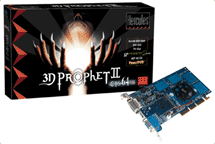 Hercules.
The name alone brings back memories of the early years of computers, the glory
days, if you will. Hercules, originally conceived in 1982, essentially created
the video card revolution. Forming a standard of video display, Hercules became
synonymous with monochrome. This tradition, of Hercules setting an industry
standard, continued through the years. Early in the days of AnandTech, Hercules
quickly gained respect around the lab as a quality manufacturer. In fact, we
choose Hercules' Dynamite TNT2 Ultra as the best TNT2 card in our July
1999 TNT2 Roundup.
Hercules.
The name alone brings back memories of the early years of computers, the glory
days, if you will. Hercules, originally conceived in 1982, essentially created
the video card revolution. Forming a standard of video display, Hercules became
synonymous with monochrome. This tradition, of Hercules setting an industry
standard, continued through the years. Early in the days of AnandTech, Hercules
quickly gained respect around the lab as a quality manufacturer. In fact, we
choose Hercules' Dynamite TNT2 Ultra as the best TNT2 card in our July
1999 TNT2 Roundup.
The problem is that Hercules is not the company that they used to be. The problems began with Hercules' bankruptcy in 1999 . Soon after the announcement, in November of the same year, a French company named Guillemot swooped in an scooped up remains of Hercules. Upon the acquisition, Guillemot took full control over Hercules' name, striping the remains of the former powerhouse and assimilating it into the lower regarded Guillemot company. The motivation behind Guillemot's investment: the Hercules name.
As mentioned before, the company formally known as Hercules was synonymous with quality. By purchasing the Hercules name, Guillemot was able to sell their products under the name of Hercules, spawning memories of the older days of the former Hercules. Since brand name recognition plays a substantial role in consumer purchase, Guillemot was able to gain a whole new image. Now, all Guillemot cards are sold under the name of Hercules, creating a false nostalgia.
In part due to the brand
name recognition Guillemot gained with the acquisition of Hercules and in part
due to an aggressive development and marketing team, Guillemot/Hercules has
produced the first 64MB GeForce 2 card we have seen, the 3D Prophet II GTS 64MB.
Does the 3D Prophet II GTS 64MB live up to the name of Hercules or do we see
once again that Hercules has merely become a name owned by Guillemot? Lets begin
by checking out the specifications.
Key Features
- Incorporates NVIDIA's latest GigaTexel Shading (GTS) GPU, the revolutionary GeForce2 GTS
- Optimized for DDR
- Incorporates NVIDIA's Shading Rasterizer (NSR) to deliver 7 pixel operations per pass
- HyperTexel architecture delivers 1.6 Gigatexels and 800 Megapixels/second
- Fast 64MB DDR memory*
- 4 dual-texturing pipelines, mapping 8 texels/clock cycle
- 200MHz core clock, 333 MHz DDR RAM clock
- Superior processing technology
- 4X AGP with Fast Writes/AGP 2X compatible
- 2nd generation hardware transform and lighting engines
- 100% hardware triangle setup
- 4 dual-texturing rendering engines produce:
- The most advanced supports for OpenGL® and DirectX® 7
- Per-pixel shading and lighting for rich, lifelike materials and cinematic effects
- 3D boards run at the fastest achievable speed
- Heatsinks on RAM units provide stability at higher clock rates
- 2nd Generation Hardware Lighting Engine
- Faster texture-mapping on objects and characters
- Finer lighting
- Rich, lifelike cinematic effects
- Processing of multiple
lights
2nd Generation Hardware Transform Engine
- Handles complex objects of over 100K polygons
- Smoother and faster movements
- Incredibly precise detailing
- Low CPU consumption
- Per-pixel Shading
- Faster texture mapping on objects and characters
- Real-time shadows
- Realistic textures with real-time rendering of per-pixel shading
- Adds depth to flat surfaces
- State-of-the-Art DDR RAM
- Offers a bandwidth of over 5, 000MB/second and 2 data transfers/RAM clock, doubling the onboard data transfer:
- Loads and maps textures more quickly
- Increases the benefit of the GeForce2 GTS' multiple pipeline architecture
- 64MB buffer lets you play complete texture-rich game levels; no texture reloads during gameplay
Visionary DVI Output
- DVI™ stands for Digital Visual Interface: The new standard for digital display supported by all major manufacturers
- DVI™ provides very high-quality digital output
- DVI™ is compatible with the former standards of digital displays: VESA®, P&D® and DFP™ (Compaq®) and only requires an adapter cable
- 3D Prophet II GTS 64MB DVI guarantees :
- High-resolution display on digital monitors
- Incredible sharpness and true color 32-bit gaming
- The best connection for digital flat panels, digital CRTs, and LCD projectors
TV/Video Output & DVD-Video Acceleration
- Advanced video architecture delivering the highest quality playback for DVD-Video and HDTV
- Extraordinary image playback with DVD titles or games on your TV: NTSC and PAL TV output in 640x480 and 800x600
- Play DVDs on your PC
- PAL TV output in 640x480 and 800x600
- Boosts 2D Performance :
- Attractive full 32-bit true color SVGA display
- Outstanding resolutions of up to 2048X1536 in 16 million colors with a 350MHz RAMDAC
The Card
Although the color of the board may not strike many as an impressive feature, being that the card will reside inside your closed system case, the RAM heatsinks are one feature that may users may find attractive upon first glance. We wont find out how effective the heatsinks are until we delve into the overclocking section, however it is clear that the heatsinks do not hinder stock performance.
This is further shown by the speeds at which the 3D Prophet II GTS 64MB was originally released at. Initially, the card came clocked at a rather impressive stock speed of 220/366 MHz, a 20 MHz overclock in the core and a 33 MHz overclock in the memory. This speed was recently brought down by the latest BIOS update from Guillemot/Hercules, reducing the card speed to the standard 200/333 MHz we have seen all other GeForce 2 GTS cards come with. Cards shipping now should be clocked at this "lower" speed, however we suspect that almost every 3D Prophet II GTS 64MB should overclock at least to the 220/333 MHz level, being that this is what the card initially shipped at.
The card comes with eight 6ns Hyundai DDR SDRAM chips mounted on the front of the board and covered by RAM heatsinks. Each heatsink hides below it 2 SDRAM chips, bonded to the heatsinks buy use of thermal tape. We will investigate in the overclocking section the advantages of these heatsinks, if any.
The, surprise, blue heatsink is the generic reference heatsink we have seen on so many other GeForce cards. Disappointingly, the heatsink is bonded to the surface of the GPU only via the side clips. A thermal pad on the bottom of the heatsink serves to aid in thermal transfer, however it is not as effective as the thermal grease we have seen in other cards. This is in contrast to the process that the old Hercules cards used to incorporate. These cards came supplied with thermal grease bonding the GPU to the heatsink, a fact which provided for cards that could overclock to a great extent. Luckily for Guillemot/Hercules, core heat does not play as great of a role in maximum overclockabilty as it used to, however it still does hinder card performance to some extent, as we will see in the overclocking section.
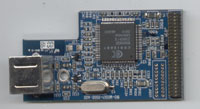 The
3D Prophet II GTS 64MB is one of the first cards we have seen come with both
TV-out and DVI-out standard. At a retail price of $420 (the card can be found
for significantly lower via a simple search), these features may not be too
much to expect from such a high priced card.
The
3D Prophet II GTS 64MB is one of the first cards we have seen come with both
TV-out and DVI-out standard. At a retail price of $420 (the card can be found
for significantly lower via a simple search), these features may not be too
much to expect from such a high priced card.
TV-output is provided via a blue daughter board which powered by the commonly
found Brooktree 869 chip. This is the same chip that has been used in NVIDIA
cards since the TNT2. As we saw in our Picture
This: TV-Output Comparison, the Brooktree 869 is a quality output chip that
should be sufficient for most video-out applications.
We were quite surprised that it took this long for a DVI port to come standard on a GeForce 2 GTS card. Since the GeForce 2 GTS GPU has a built in TMDS decoder, there is no need for the external chip that we saw on GeForce 256 based cards. As you can see by the picture, the only thing that adding DVI-out support requires is a DVI-out port, a cheap add on from any manufacturer's perspective. Including the DVI-out port ensures at least an upgrade path for those out there interested in keeping the card for an extended period of time.
Overclocking
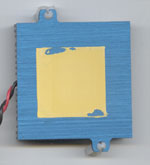 As
mentioned before, the 3D Prophet II GTS 64MB's blue heatsink comes bonded to
the GPU surface via a thermal pad. This means that the only thing keeping the
heatsink on the GPU are the side clips, a fact which results in poor thermal
transfer from the core to the cooling surface.
As
mentioned before, the 3D Prophet II GTS 64MB's blue heatsink comes bonded to
the GPU surface via a thermal pad. This means that the only thing keeping the
heatsink on the GPU are the side clips, a fact which results in poor thermal
transfer from the core to the cooling surface.
This poor heat transfer can be seen by the relatively low core overclock that the 3D Prophet II GTS 64MB was able to achieve: a relatively meager 230 MHz. As we suspected, the card had no problem reaching its original shipping speed of 220 MHz. The use of a better thermal compound would most likely help for further overclocking, however we found in our Overclocking the GeForce 2 GTS guide that core speed does not really effect card speed to greatly due to the fact that the GeForce 2 GTS is severely memory limited.
Speaking of memory bandwidth, it is time to see how those memory heatsinks perform. While the heatsinks may seem like a novel idea, they actually provide little benefit for maximum speed of the memory chips. This is due to the fact that memory chips actually act like a capacitor, producing a charge or discharge for the 1's and 0's that are sent to it. Due to this, memory chips do not produce a substantial amount of heat. The low heat generation from RAM can be seen by placing one's finger on a RAM chip. They generally prove to be only warm. This is in contrast to the transistor based world of processors, which generate substantially more heat. As a result of this, heatsinks are most commonly found on transistor based devices, such as the GeForce 2 GTS processor itself. We almost never see system memory (which works the same way as video card memory) with heatsinks on the RAM because they do not produce enough heat to necessitate cooling.
With or without RAM heatsinks, the card should perform the same. We were able to get the memory clock up to an impressive 200 MHz DDR (400 MHz effective), however this was not a result of the RAM heatsinks but rather a product of chip quality, design, process, ect, elements which we have found to be generally good for Hyundai RAM.
We can therefore conclude that the RAM heatsinks are generally only tack on additional price to a card. With or without the RAM heatsinks, the 3D Prophet II GTS 64MB should perform identically. It seems that the heatsinks were merely added by Guillemot/Hercules to provide visual eye candy to lure in potential buyers and offer little real world application.
Regardless, the memory clock of the 3D Prophet II GTS 64MB proved to overclock well. The 400 MHz memory clock in collaboration with the 230 MHz core clock provided for one fast card.
The Drivers
Running the installation program for the Guillemot/Hercules 3D Prophet II GTS 64MB revealed an interesting fact. Rather than automate the installation, the included setup program is nothing more than a macro that clicks the correct buttons at the required dialog boxes. Not very pretty, but it does get the job done.
Once installed, we found that the drivers included with the 3D Prophet II GTS 64MB were 5.22 based (as downloaded from Guillemot/Hercules' web site). This means that the card comes with the latest official reference drives from NVIDIA. Not surprisingly, we find that the driver set that comes with the package looks nearly identical to NVIDIA's reference drivers with the Hercules logo thrown in here and there. One nice feature is that Guillemot/Hercules decided to throw in the overclocking tab in their standard install.
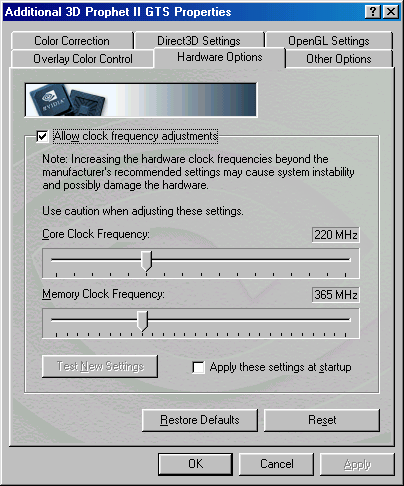
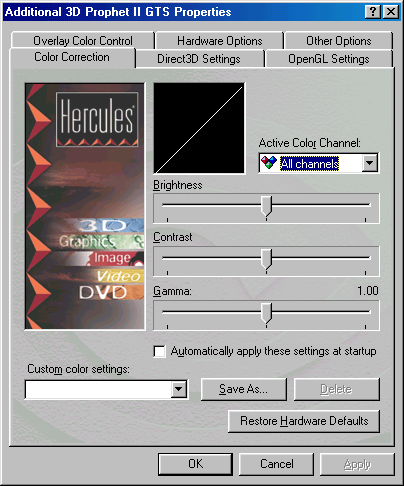
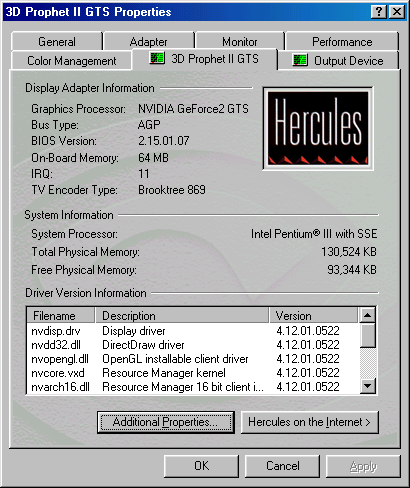
The Test
|
|
Windows
98 SE Test System
|
|
|
Hardware
|
|
CPU(s) |
Intel
Pentium III 750E |
| Motherboard(s) |
ABIT
BF6
|
| Memory |
128MB PC133 Crucial Technology SDRAM |
| Hard Drive |
Westen Digital Caviar 205AA 20GB UDMA 33 |
| CDROM |
Acer 24x |
| Video Card(s) |
Guillemot/Hercules 3D Prophet II GTS 64MB |
|
|
Software
|
|
Operating System |
Windows 98 SE |
| Video Drivers |
|
|
|
Benchmarking Applications
|
| Gaming |
idSoftware
Quake III Arena demo001.dm3 |
Quake III Arena Performance- demo001
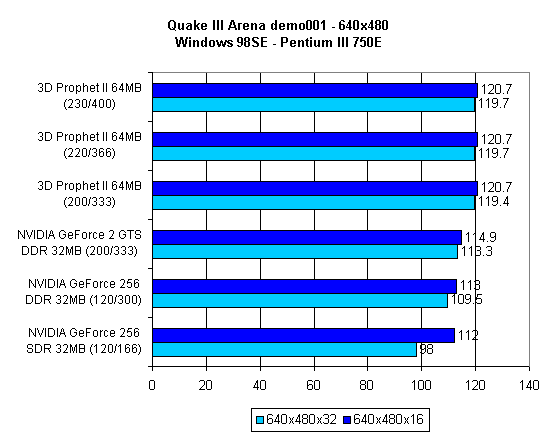
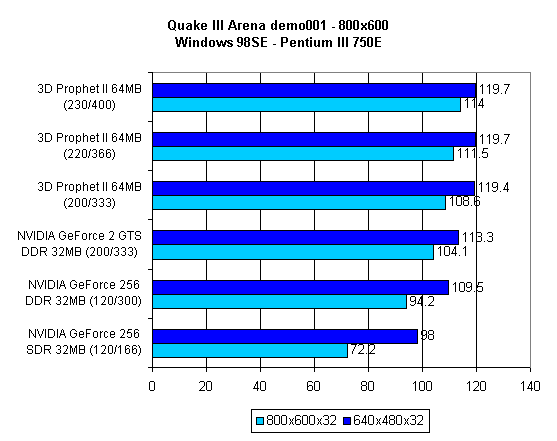
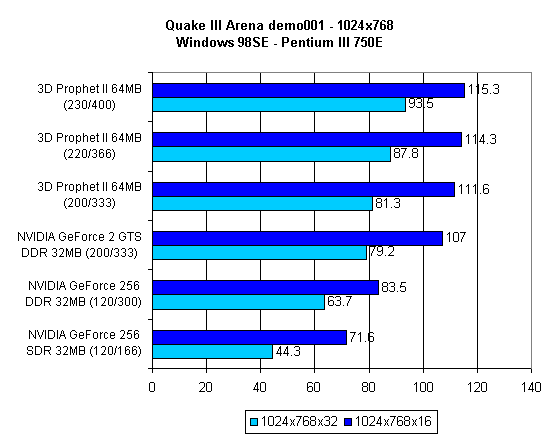
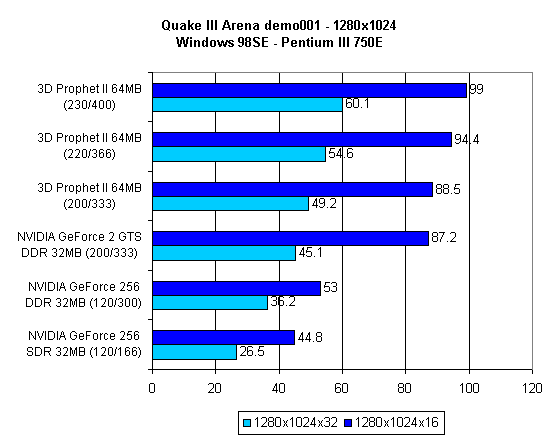

As can be seen by the graphs, the 3D Prophet II GTS 64MB at its stock speed generally performs higher than the 32 MB GeForce 2 GTS. This is essentially the same results that we found in our 64MB GeForce 2 GTS review, with the 3D Prophet II GTS performing a maximum of 8.5% faster than the equivalently clocked 32 MB GeForce 2 GTS at 1600x1200x16.
We also included benchmarks for 220/366, as there are still some cards out there that will come at these speeds. As mentioned before, it is highly likely that every 3D Prophet II GTS 64MB will be able to hit these speeds. At these higher memory and core speeds, the card performed 19.6% faster than the stcok clocked 32MB GeForce 2 GTS when at 1600x1200x16
The final performance boost came when the card was clocked to its maximum speed of 230/400 MHz. At these levels, the 3D Prophet II GTS 64MB has almost no competitor. The card performed 30% faster than the stock clocked 32MB GeForce 2 GTS. When the 3D Prophet II GTS 64MB was pushed to this high level, there was almost no looking back. Quake III Arena played the fastest we have seen so far.
Quake III Arena Performance- Quaver
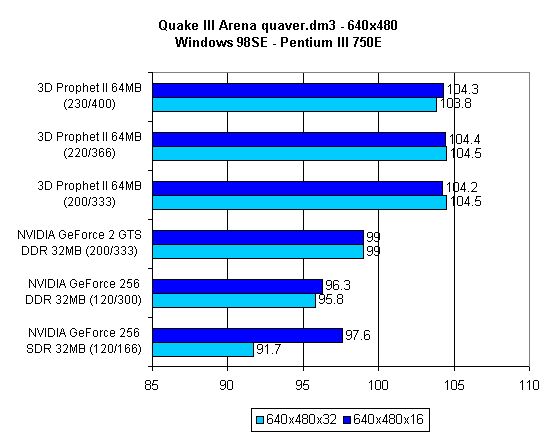
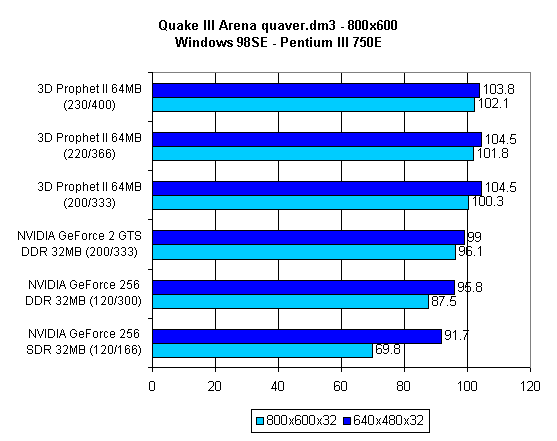
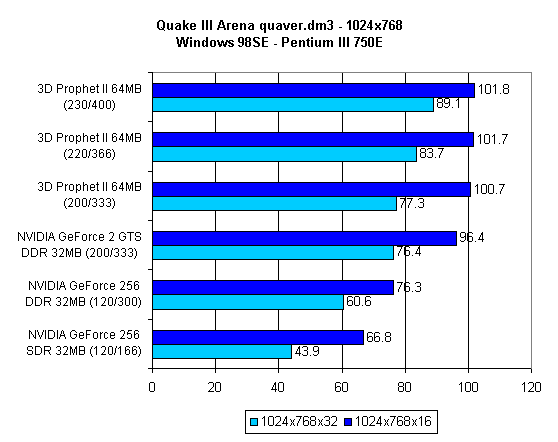
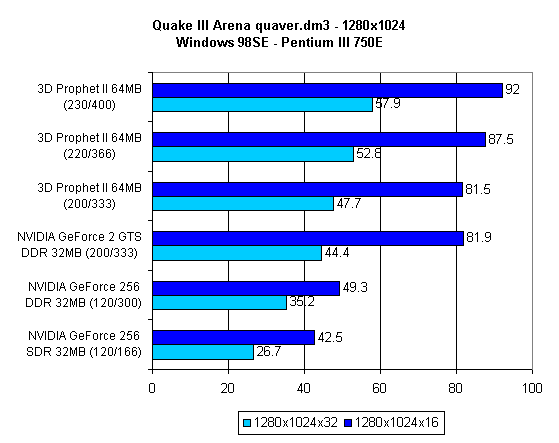
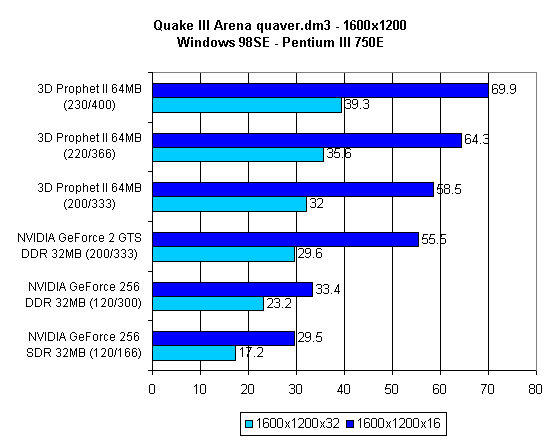
The Quaver benchmark does not stress cards like it used to. As we saw in our 64MB GeForce 2 GTS Review, the implementation of S3TC seems to have eliminated the memory space problems that Quaver used to cause. We find that in Quaver, results remain nearly identical to the benchmarks run on the less stressful demo001 benchmark.
We find that at 1600x1200x16, the stock clocked card performs 5.4% faster than the stock clocked 32MB GeForce 2 GTS. This performance margin reaches 15.8% higher when at 220/366 and 26% faster at the maximum speed of 230/400.
Conclusion
Does the 3D Prophet II GTS 64MB live up to it's Hercules namesake? To answer this question, we must first look at the card itself.
We find that many things have changed since the days of the old Hercules. No longer is the Hercules name synonymous with the highest quality products. This is reflected in the lack of thermal compound binding the GPU to the heatsink surface on the 3D Prophet II GTS 64MB. In addition, the extra features of the card prove to be, for the most part, useless. The addition of the RAM heatsinks prove to provide no advantage over non-cooled RAM solutions and simply raises the price of the card more.
For every down side of the 3D Prophet II GTS 64MB it seems that there is also an upside. This card is the first one we have seen to offer both DVI and TV-out standard; both useful features that if you do not use now you could very well use in the future. Especially with the high price of $420 retail, the 3D Prophet II GTS 64MB is most definitely a card that you would want to hold onto for a long time,
Besides the addition of a software based DVD player, a useful feature when paired with the TV-out capabilities, the Guillemot/Hercules 3D Prophet II GTS 64MB does not include any software bundle package. This is rather disappointing, especially since we have recently seen the level of included software take a step up. However, if it continues to keep prices down on this already expensive card, we are all for it.
As stated in our 64MB GeForce 2 GTS review, 64MB GeForce 2 GTS based cards are for those wanting power. Since the 3D Prophet II GTS 64MB is the first 64MB GeForce 2 GTS card to hit the market, it seems that one would want to buy one relatively quickly for maximum product life span. The only downside to this is that prices are bound to fall shortly as more and more 64MB GeForce 2 GTS cards are scheduled to come out. As far as 64MB GeForce 2 GTS cards seem to be going, the 3D Prophet II GTS 64MB does not seem to be a bad purchase, especially considering the $360 pirce tag that it can be found for on the web. While the 3D Prophet II GTS does not overly impress, it does not disappoint.
How It Rates
Please note that the score given is a comparison between the Guillemot/Hercules and other 64MB GeForce 2 GTS cards on the market. This is not meant to reflect how 64MB GeForce 2 GTS cards compare to other video cards on the market processor wise. To find this information, please see our 64MB NVIDIA GeForce 2 GTS review. Also keep in mind that a score of five indicates standard performance. To learn more about our rating system, please click here.
|
AnandTech Video Card Rating |
|
|
Rating
(x/10)
|
|
|
Performance
|
5.0
|
|
Price
|
6.0
|
|
Drivers
|
5.0
|
|
Features
|
6.5
|
|
Retail Availability
|
8.0
|
|
Documentation & Software Bundle
|
5.0
|
| Overall Rating |
6.0
|
Note: The Overall Rating is not an average of all of the categories









